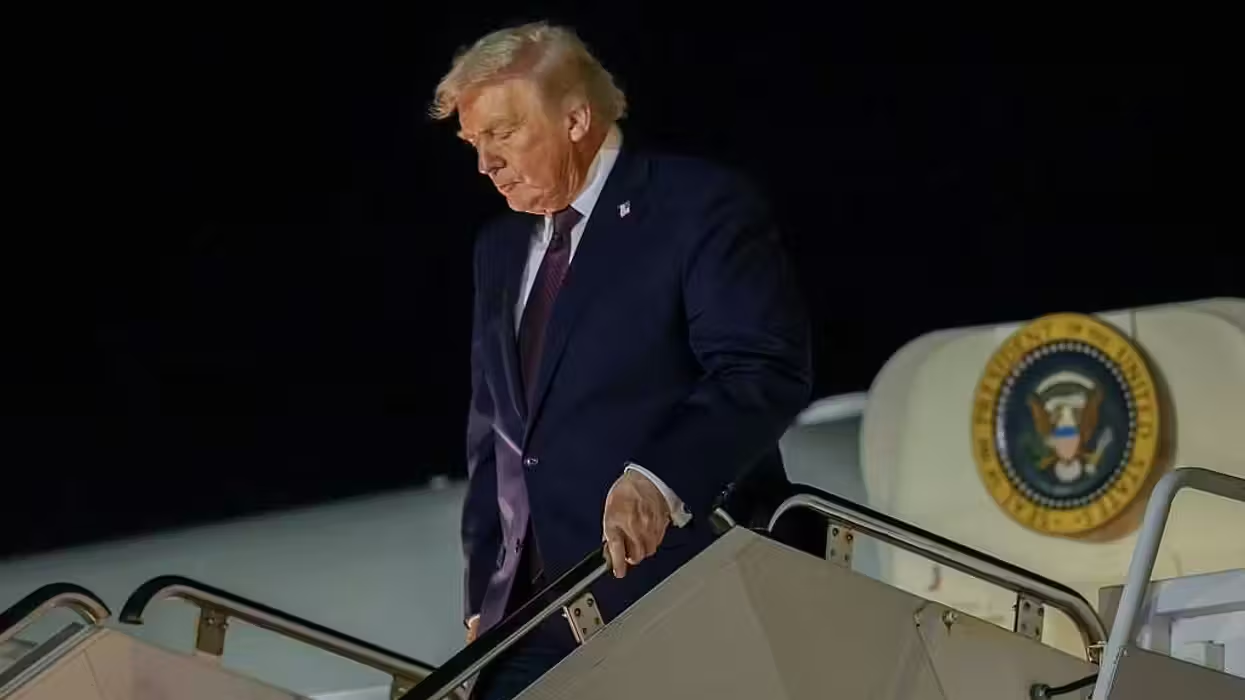
© 2025 Blaze Media LLC. All rights reserved.
Economist Rickards: Collapse of the dollar and international monetary system is entirely foreseeable
April 09, 2014
"The economy is broken, and inflation is on its way"
Lawyer, economist and investment banker James Rickards, he of the best-selling 2011 "Currency Wars: The Making of the Next Global Crisis," has a provocative new book out titled "The Death of Money: The Coming Collapse of the International Monetary System."

Writing in the American Enterprise Institute's "The American" magazine in an essay adopted from his new book, Rickards argues that the dollar and international monetary system is going to collapse -- and it is entirely foreseeable.
According to Rickards, today the world is "back to the future," with current conditions paralleling those during the 1970s, in which the U.S. experienced mass inflation, with gold prices rising 500 percent between 1977 and 1980, and the dollar very nearly collapsed as the world's reserve currency. However,
"The parallels between 1978 and recent events are eerie but imperfect. There was an element ravaging the world then that is not apparent today. It is the dog that didn’t bark: inflation. But the fact that we aren’t hearing the dog doesn’t mean it poses no danger. And from the Federal Reserve’s perspective, inflation is not a threat; indeed, higher inflation is both the Fed’s answer to the debt crisis and a policy objective."
[sharequote align="center"]Higher inflation is both the Fed’s answer to the debt crisis and a policy objective[/sharequote]
This pro-inflation policy is an invitation to disaster, even as baffled Fed critics scratch their heads at the apparent absence of inflation in the face of unprecedented money printing by the Federal Reserve and other major central banks. Many ponder how it is that the Fed has increased the base money supply 400 percent since 2008 with practically no inflation."
Why have we seen a massive increase in the monetary base without a subsequent general steep rise in prices across all goods and services, contrary to the predictions of many free-marketeers and other Fed critics?
 The monetary base has increased rapidly from $858bn to $3.9tn from the start the recession in 2008 to today. (Image Source: FRED/Federal Reserve Bank of St. Louis)
The monetary base has increased rapidly from $858bn to $3.9tn from the start the recession in 2008 to today. (Image Source: FRED/Federal Reserve Bank of St. Louis)
According to Rickards:
"two explanations are very much at hand — and they foretell the potential for collapse. The first is that the U.S. economy is structurally damaged, so the easy money cannot be put to good use. The second is that the inflation is coming. Both explanations are true — the economy is broken, and inflation is on its way."
Rickards argues that the models used on Wall Street and by financial regulators mask the overleveraging of the economy and the dangers posed by derivatives (financial instruments whose value is derived from the performance of an underlying asset). Meanwhile,
"we refuse to face truths about debts and deficits, dozens of countries all over the globe are putting pressure on the dollar. We think the gold standard is a historical relic, but there’s a contemporary scramble for gold around the world, and it may signify a move to return to the gold standard. We greatly underestimate the dangers from a cyberfinancial attack and the risks of a financial world war."
And just as with the prior financial crisis, which was arguably amplified by flawed financial models: "Regression analysis and correlations, so beloved by finance quants and economists, are ineffective for navigating the risks ahead."
 The total notional value of all outstanding derivatives is ~$700 trillion according to the Bank of International Settlements' (BIS) most recent derivatives statistics, which are based on surveys of the world's largest derivative dealers. The notional amount represents the total exposure of a leveraged market position, or the underlying value of the assets the derivatives in question represent -- for example owning a handful of stock option contracts that cost $1,000, for which the market value of the actual stock controlled is $10,000. (Source: BIS)
The total notional value of all outstanding derivatives is ~$700 trillion according to the Bank of International Settlements' (BIS) most recent derivatives statistics, which are based on surveys of the world's largest derivative dealers. The notional amount represents the total exposure of a leveraged market position, or the underlying value of the assets the derivatives in question represent -- for example owning a handful of stock option contracts that cost $1,000, for which the market value of the actual stock controlled is $10,000. (Source: BIS)
Rickards goes on to explain that:
"Since potential risk is an exponential function of system scale, and since the scale of financial systems measured by derivatives is unprecedented, it follows that the risk too is unprecedented.
[instory-book ISBN="9781591846703"]
While the word collapse as applied to the dollar sounds apocalyptic, it has an entirely pragmatic meaning. Collapse is simply the loss of confidence by citizens and central banks in the future purchasing power of the dollar. The result is that holders dump dollars, either through faster spending or through the purchase of hard assets. This rapid behavioral shift leads initially to higher interest rates, higher inflation, and the destruction of capital formation. The end result can be deflation (reminiscent of the 1930s) or inflation (reminiscent of the 1970s), or both.The coming collapse of the dollar and the international monetary system is entirely foreseeable. This is not a provocative conclusion. The international monetary system has collapsed three times in the past century — in 1914, 1939, and 1971. Each collapse was followed by a tumultuous period. The coming collapse, like those before, may involve war, gold, or chaos, or it could involve all three. The most imminent threats to the dollar, likely to play out in the next few years, are financial warfare, deflation, hyperinflation, and market collapse. Only nations and individuals who make provision today will survive the maelstrom to come."
Be sure to check out the full article here.
Want to leave a tip?
We answer to you. Help keep our content free of advertisers and big tech censorship by leaving a tip today.
Want to join the conversation?
Already a subscriber?
Ben Weingarten is a writer, commentator, and editor at large at RealClearInvestigations. He is a senior contributor at the Federalist and writes columns for Newsweek and the Epoch Times.
Ben Weingarten
Ben Weingarten is a writer, commentator, and editor at large at RealClearInvestigations. He is a senior contributor at the Federalist and writes columns for Newsweek and the Epoch Times.
more stories
Sign up for the Blaze newsletter
By signing up, you agree to our Privacy Policy and Terms of Use, and agree to receive content that may sometimes include advertisements. You may opt out at any time.
Related Content
© 2025 Blaze Media LLC. All rights reserved.
Get the stories that matter most delivered directly to your inbox.
By signing up, you agree to our Privacy Policy and Terms of Use, and agree to receive content that may sometimes include advertisements. You may opt out at any time.






